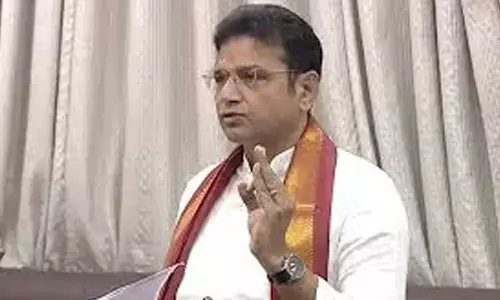Air quality turns grim in Indian cities

Struck in the slow moving traffic for hours together, intermediated with traffic jams, tells you how much of pollution exhausts must be adding to the city’s air pollution levels.
A few days back, a young lady from Bengaluru put out a tweet. She was driving back to her house with her two children in the car. She narrated her harrowing experience of being stuck in the traffic for over three hours even though her home was just about 5 km away. That reminds me of my last visit to Bengaluru, and that was before the pandemic struck, and there was hardly a day when I didn't spend close to four hours commuting to and fro through the city's busy roads.
Struck in the slow moving traffic for hours together, intermediated with traffic jams, tells you how much of pollution exhausts must be adding to the city's air pollution levels. While the car owner would say that he had his windows up and had the car's air-conditioner switched on, the slow moving traffic certainly spewed harmful gases into the atmosphere.
A study by the Centre for Study of Science, Technology and Policy now tells us that transportation is responsible for 51 per cent of Bengaluru's pollution. Bengaluru is no exception. The latest World Air Quality Report 2021, released by IQAir, a Swiss organisation, found that 35 of the 50 cities globally with the worst air quality parameters were in India. This speaks a lot about the development pathway the country has undertaken for some decades.
The rate of urbanisation, coming with a push from public policy, and without adequate infrastructure and public health design being first put in place, has exacerbated the air pollution levels in our cities.
In 48 per cent of Indian cities, air pollution levels exceed the limit set by the World Health Organisation (WHO) by ten times. The report tells us that none of the cities in India met the prescribed air quality standard of 5 micrograms per cubic metre. In fact, Delhi continues to top the global tally for the fourth consecutive year in a row.
While we are well aware that air pollution has a huge impact on human health, another elaborate study by the Lancet Plenary Health that was released on Tuesday dropped a bombshell. With 9 million people globally succumbing to air pollution in 2019, the study estimates that nearly 18 per cent of these deaths occurred in India. Simply put, it means a staggering 16.7 lakh people have died from air pollution in India alone, and that too in one year. I am sure you will agree this is not a death toll that can be easily dismissed as something that is inevitable. Nor is it a collateral damage arising from an industrial pathway of development that India has decided to follow, and many would say it is a small price for achieving a higher growth trajectory.
No, it isn't anything like that. It is a serious matter. After all, India tops the world as far as loss of life from air pollution is concerned, as the study observes. The death toll from air-pollution exceeds the official number of deaths accruing from the second wave of Covid-19 pandemic. Majority of these deaths were triggered by PM 2.5 particles – the superfine dust particles that hits the lungs first, and gradually leads to premature deaths. The study also finds out that the world's highest weighted average for PM 2.5 levels is in India.
Well, the study points out that high PM 2.5 levels come from vehicular, road and industrial pollution, besides some other causes like burning of biomass etc. With the number of vehicles expected to increase in the years to come, and with stringiest pollution norms being proposed time and again for keeping vehicular pollution under control, I don't think vehicular pollution levels will actually come down significantly in the years to come. In my own middle class locality where I live in Chandigarh tri-city, the number of vehicles is soaring. The situation is no better in other cities. The problem created by too many cars and hardly any open space left for parking, is leading of course to frequent brawls.
The efficiency and performance of the latest automobile brands has certainly improved. And with household income levels improving, a new trend for buying Sport Utility Vehicles (SUVs) is emerging. There are 96 SUV cars in India being currently produced by various automobile manufacturers. This only shows how the SUV cars have now become a new status symbol. While the craze is for replacing the existing car with a pre-eminent SUV car, depending on how much one can shell out, what people do not realise is that the SUVs they are buying releases a still harmful exhaust, which is worse for human health and also for the climate.
Even during the two years of pandemic, while the global carbon emissions fell, the increasing preference for SUVs saw an increase in emissions. A study by the International Energy Agency found that the SUVs are the second largest contributor to the global carbon dioxide emissions. In fact, after the power sector, the SUVs rank second in the polluting category.
According to The Guardian, if all the SUVs were to be put together, and seen as a country, it would rank seventh in global carbon emission ranking. In 2020, the sale of SUVs world over increased by a whopping 42 per cent. In Europe, SUVs have replaced 50 per cent of the cars on road. In India, more than 93-lakh SUV cars have been sold in the past 16 years. With petrol and diesel SUVs known to be emitting 25 per cent more carbon dioxide than an average small car, imagine the huge addition to air pollution levels being made by SUVs every year. And yet, I don't see any feeling of guilt or remorse among those who flaunt their newly acquired status symbol. These are the same people who don't spare a moment to blame Punjab farmers for instance for stubble burning during the paddy harvest season that worsens air quality standards in Delhi for three weeks or so.
We live in times when everyone finds it convenient to blame others for the environmental crisis. But since their own lifestyle needs to be protected, I haven't seen the elite in the cities demanding a curb on SUV sales. Nor have the car manufacturers been ever asked to impose a cap on the annual production of SUV cars. The simple reason being that those who hold responsibility to examine and initiate correcting measures are by and large themselves driving SUV cars. Most Ministers do; most bureaucrats do; and most senior editors too do. Who then you think would like to give up his own privilege to set the air pollution balance right for you?
(The author is a noted food policy analyst and an expert on issues related to the agriculture sector)















